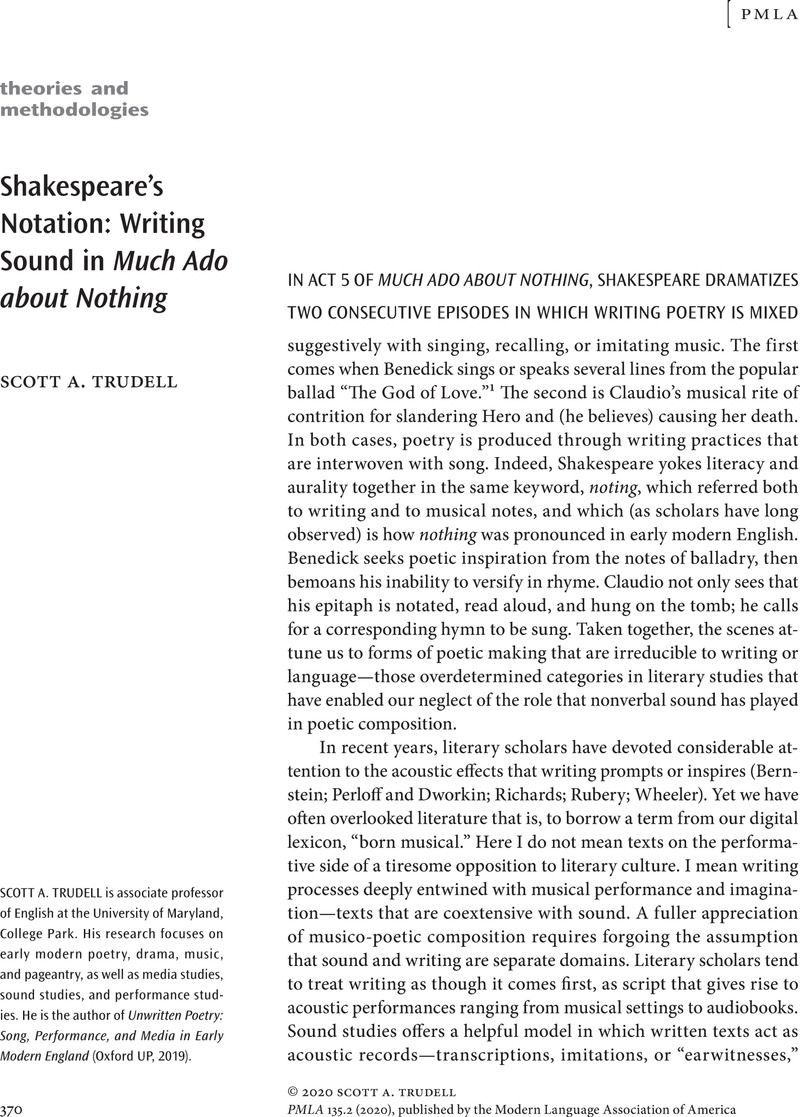No CrossRef data available.
Article contents
Shakespeare's Notation: Writing Sound in Much Ado about Nothing
Published online by Cambridge University Press: 23 October 2020
Abstract
An abstract is not available for this content so a preview has been provided. Please use the Get access link above for information on how to access this content.

- Type
- Theories and Methodologies
- Information
- Copyright
- Copyright © 2020 Scott A. Trudell
References
Works Cited
Bernstein, Charles, editor. Close Listening: Poetry and the Performed Word. Oxford UP, 1998.CrossRefGoogle Scholar
Chaganti, Seeta. Strange Footing: Poetic Form and Dance in the Late Middle Ages. U of Chicago P, 2018.CrossRefGoogle Scholar
Cheney, Patrick. English Authorship and the Early Modern Sublime: Spenser, Marlowe, Shakespeare, Jonson. Cambridge UP, 2018.CrossRefGoogle Scholar
Cheney, Patrick “Halting Sonnets: Poetry and Theater in Much Ado about Nothing.” A Companion to Shakespeare's Sonnets, edited by Schoenfeldt, Michael, Blackwell Publishing, 2007, pp. 363–82.Google Scholar
Collington, Philip D. “A ‘Pennyworth’ of Marital Advice: Bachelors and Ballad Culture in Much Ado about Nothing.” Shakespeare's Comedies of Love: Essays in Honour of Alexander Leggatt, edited by Bamford, Karen and Knowles, Ric, U of Toronto P, 2008, pp. 30–54.Google Scholar
Crunelle-Vanrigh, Anny. “Much Ado about Dancing.” Studies in English Literature, Vol. 57, No. 2, 2017, pp. 275–301.Google Scholar
Dawson, Anthony B. “Much Ado about Signifying.” Studies in English Literature, Vol. 22, No. 2, 1982, pp. 211–21.CrossRefGoogle Scholar
Dobranski, Stephen B. “Children of the Mind: Miscarried Narratives in Much Ado about Nothing.” Studies in English Literature, Vol. 38, No. 2, 1998, pp. 233–50.CrossRefGoogle Scholar
Dubrow, Heather. The Challenges of Orpheus: Lyric Poetry and Early Modern England. Johns Hopkins UP, 2008.Google Scholar
Dugan, Holly. “Desiring H: Much Ado about Nothing and the Sound of Women's Desire.” Queer Shakespeare: Desire and Sexuality, edited by Stanivukovic, Goran, Bloomsbury, 2017, pp. 137–52.Google Scholar
Goldring, Elizabeth. “Elderton, William (d. in or before 1592).” Oxford Dictionary of National Biography, Oxford UP, 2004, doi:10.1093/ref:odnb/8614.Google Scholar
Greenblatt, Stephen. Introduction to Much Ado about Nothing. The Norton Shakespeare, 3rd ed., edited by Greenblatt, et al., W. W. Norton, 2016, pp. 1395–403.Google Scholar
Henderson, Diana E. “Mind the Gaps: The Ear, the Eye, and the Senses of a Woman in Much Ado about Nothing.” Knowing Shakespeare: Senses, Embodiment and Cognition, edited by Gallagher, Lowell and Raman, Shankar, Palgrave Macmillan, 2010, pp. 192–215.Google Scholar
Henze, Catherine A. Robert Armin and Shakespeare's Performed Songs. Routledge, 2017.CrossRefGoogle Scholar
Hunt, Maurice. “The Reclamation of Language in Much Ado about Nothing.” Studies in Philology, Vol. 97, No. 2, 2000, pp. 165–91.Google Scholar
Jackson, Virginia “Lyric.” The Princeton Encyclopedia of Poetry and Poetics, 4th ed., edited by Greene, Roland et al., Princeton UP, 2012, pp. 826–34.Google Scholar
Johnson, J. W. “Lyric.” The New Princeton Encyclopedia of Poetry and Poetics, edited by Preminger, Alex and Brogan, T. V. F., Princeton UP, 1993, pp. 713–27.Google Scholar
Kiefer, Frederick. “Poems as Props in Love's Labor's Lost and Much Ado about Nothing.” Reading and Literacy in the Middle Ages and Renaissance, edited by Moulton, Ian Frederick, Brepols, 2004, pp. 127–41.Google Scholar
Larson, Katherine R. The Matter of Song in Early Modern England: Texts in and of the Air. Oxford UP, 2019.CrossRefGoogle Scholar
Lin, Erika T. Shakespeare and the Materiality of Performance. Palgrave Macmillan, 2012.CrossRefGoogle Scholar
Long, John H. Shakespeare's Use of Music: A Study of the Music and Its Performance in the Original Production of Seven Comedies. 1955. U of Florida P, 1961.Google Scholar
Nelson, Brent. “Faith and Sheep's Guts in Much Ado about Nothing.” Shakespeare, Vol. 12, No. 2, 2016, pp. 161–74.Google Scholar
“Nonny-no, N. and Int.” Oxford English Dictionary, Oxford UP, 2019, www.oed.com/view/Entry/128014.Google Scholar
“Nonny-nonny, Int. and N.” Oxford English Dictionary, Oxford UP, 2019, www.oed.com/view/Entry/128015.Google Scholar
“Note, V.2.” Oxford English Dictionary, Oxford UP, 2019, www.oed.com/view/Entry/128550.Google Scholar
“Nothing, Pron., and N., Adv., and Int.” Oxford English Dictionary, Oxford UP, 2019, www.oed.com/view/Entry/128579.Google Scholar
Perloff, Marjorie, and Dworkin, Craig, editors. The Sound of Poetry / The Poetry of Sound. U of Chicago P, 2009.CrossRefGoogle Scholar
Ramazani, Jahan, and Tucker, Herbert F., editors. Song. Special issue of New Literary History, Vol. 46, No. 4, 2015.CrossRefGoogle Scholar
Richards, Jennifer. Voices and Books in the English Renaissance: A New History of Reading. Oxford UP, 2019.CrossRefGoogle Scholar
Schafer, R. Murray. The Soundscape: Our Sonic Environment and the Tuning of the World. 1977. Destiny Books, 1994.Google Scholar
Shakespeare, William. Much Ado about Nothing. Rev. ed., edited by Claire McEachern, Arden Shakespeare, 2006.Google Scholar
Trudell, Scott A. Introduction. The Intermedia Restoration, special issue of Restoration, edited by Trudell, Vol. 42, No. 2, 2018, pp. 3–11.CrossRefGoogle Scholar
Trudell, Scott A. Unwritten Poetry: Song, Performance, and Media in Early Modern England. Oxford UP, 2019.CrossRefGoogle Scholar
“Utter, V.1.” Oxford English Dictionary, Oxford UP, 2019, www.oed.com/view/Entry/220816.Google Scholar
“Utter, V.2.” Oxford English Dictionary, Oxford UP, 2019, www.oed.com/view/Entry/2208167.Google Scholar
Wheeler, Lesley. Voicing American Poetry: Sound and Performance from the 1920s to the Present. Cornell UP, 2008.Google Scholar




